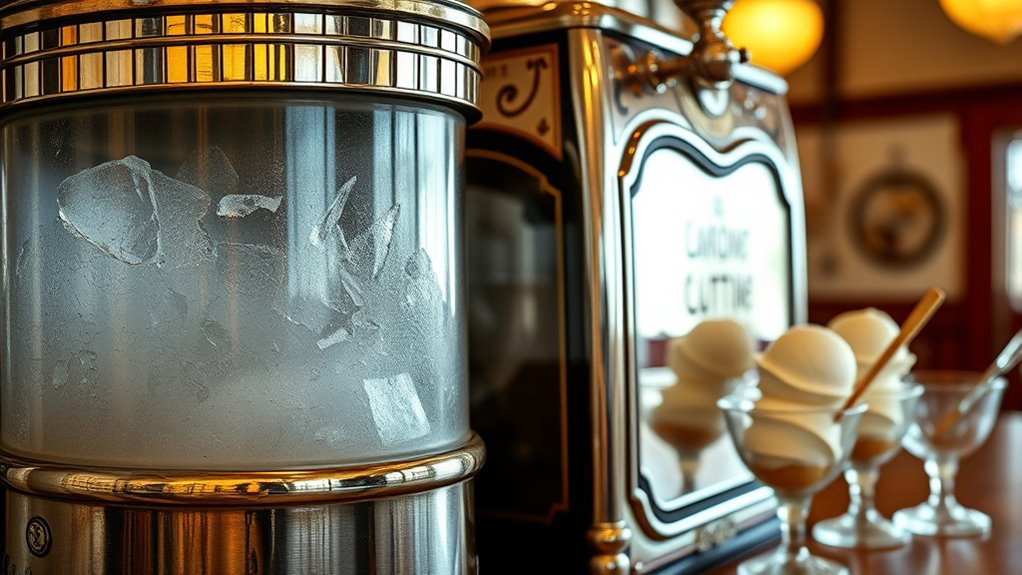The history of commercial ice cream machines begins in the early 20th century when inventors aimed to produce ice cream more efficiently. Over time, innovations like continuous freezers, automatic controls, and better materials sped up production, improved quality, and reduced costs. These advancements transformed ice cream from a handcrafted luxury into a popular, accessible treat worldwide. If you want to discover how technology continually shaped this delicious industry, there’s much more to explore.
Key Takeaways
- Early 20th-century inventions revolutionized ice cream production, shifting from handcrafted to large-scale manufacturing.
- Introduction of continuous freezers and automation improved speed, texture control, and product consistency.
- Technological advancements reduced costs, increased capacity, and enabled industry scaling for wider market access.
- User-friendly features and sanitation improvements expanded production to small businesses and global markets.
- Innovations fostered industry growth, making ice cream more affordable, diverse, and globally popular.

The history of commercial ice cream machines traces back to the early 20th century when inventors began developing devices to produce large quantities of ice cream efficiently. During this period, advancements in ice cream technology revolutionized how the treat was made and distributed, transforming a once handcrafted luxury into a widespread commodity. Early machines were simple, relying on basic refrigeration methods, but they laid the groundwork for more sophisticated manufacturing innovations that would follow. As demand grew, inventors focused on improving efficiency, consistency, and capacity, which led to the creation of larger, more reliable equipment capable of handling commercial-scale production. These innovations didn’t just enhance productivity—they also improved the quality and texture of ice cream, making it more appealing to consumers.
You’ll find that the evolution of ice cream technology was driven by the need to streamline manufacturing processes. Innovations such as continuous freezers and double-action machines allowed for faster production cycles and better control over the product’s texture. These developments meant that manufacturers could produce uniform batches of ice cream at a much higher volume, reducing waste and lowering costs. As the industry advanced, new materials and mechanical designs emerged, further boosting efficiency. For example, the introduction of more precise temperature controls and automatic mixing systems helped ensure each batch met high standards of quality. These manufacturing innovations not only increased output but also made it easier for ice cream companies to scale up operations, meeting the demands of a growing market. Additionally, automation technology played a significant role in maintaining consistency across large production runs. The integration of reliable refrigeration systems was essential in achieving consistent quality, further propelling the industry forward. Furthermore, ongoing research into energy-efficient components contributed to reducing operational costs, making large-scale production more sustainable.
You might also notice how technological progress influenced the design and functionality of commercial ice cream machines. Over time, machines became more user-friendly, with features like automated controls and improved sanitation systems. This progress meant that even smaller businesses could afford and operate high-quality equipment, broadening the reach of ice cream production. The integration of refrigeration technology into these machines was a game-changer, enabling manufacturers to produce frozen treats consistently and efficiently. Additionally, the development of automated controls was crucial in standardizing production quality and reducing manual labor. This constant push for better ice cream technology and manufacturing innovations helped establish the foundation for the diverse range of ice cream products available today. It’s fascinating to see how each new invention contributed to making ice cream more accessible, affordable, and enjoyable for millions worldwide.
Frequently Asked Questions
How Do Commercial Ice Cream Machines Differ From Household Models?
You’ll notice that commercial ice cream machines differ from household models mainly in machine capacity and flavor customization. Commercial machines handle larger volumes, so they’re built for high demand and continuous use. They also offer more advanced flavor options, allowing you to experiment with mixes and add-ins. This makes them ideal for restaurants or ice cream shops, where serving variety and efficiency is key, unlike smaller household models designed for personal use.
What Maintenance Is Required for Commercial Ice Cream Machines?
Imagine a busy kitchen where your commercial ice cream machine hums smoothly. To keep it running perfectly, you need to follow cleaning protocols regularly, ensuring all parts are sanitized and free of residue. Don’t forget refrigerant checks, which keep the cooling system efficient. Regular maintenance prevents breakdowns, extends its lifespan, and guarantees your ice cream stays deliciously cold and creamy for your customers.
Are There Environmental Impacts Associated With Ice Cream Machine Manufacturing?
You might wonder if ice cream machine manufacturing impacts the environment. Yes, it can, especially if sustainable manufacturing practices aren’t followed. Some companies implement recycling initiatives to reduce waste and lower their carbon footprint. By choosing machines from eco-conscious manufacturers, you support sustainability and help minimize environmental impacts. Always ask about their manufacturing processes and recycling programs to guarantee you’re making environmentally friendly choices when investing in commercial ice cream equipment.
How Have Ice Cream Flavors Evolved With Machine Technology?
You see, with advancements in ice cream machine technology, you can now explore endless flavor experimentation and ingredient customization. Modern machines allow you to create unique combinations, blending textures and ingredients to suit your taste. This innovation encourages creativity, letting you craft personalized flavors that weren’t possible before. As a result, you enjoy a broader variety of ice cream options, making each scoop a delicious reflection of your preferences and inventive spirit.
What Innovations Are Shaping the Future of Commercial Ice Cream Machines?
You’ll see that the future of commercial ice cream machines focuses on innovations like automated dispensing and flavor customization. These advancements let you offer customers personalized treats quickly and efficiently. With automated systems, you can streamline operations and reduce waste, while flavor customization allows you to cater to diverse tastes. Embracing these innovations means you stay ahead in the industry, providing unique, high-quality ice cream experiences that meet modern demand.
Conclusion
Now that you’ve discovered the delightful, daring developments behind commercial ice cream machines, you can appreciate their incredible innovation and inspiring ingenuity. From early experiments to modern marvels, these machines have made mesmerizingly moreish ice cream accessible everywhere. So, next time you savor a scoop, remember the fascinating, fabulous history that brought this frozen fun to life. It’s a fantastic fusion of technology, tradition, and tasty treats—truly a proof to timeless, tempting innovation!









